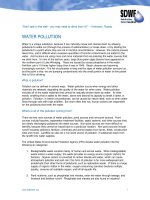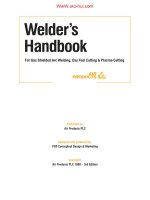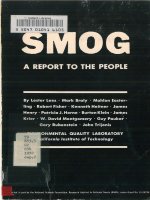Guidelines To Gas Tungsten Arc Welding (GTAW)_2 docx
Bạn đang xem bản rút gọn của tài liệu. Xem và tải ngay bản đầy đủ của tài liệu tại đây (1.04 MB, 10 trang )
Page 9
3
-7. Suggested Inverter Power Source Starting Parameters For Various Aluminum Joints
Butt Joint
Amperage: 90-120
Balance: 70-80%
Frequency: 60-120 Hz
Base Material Alloy: 6061
Base Material Thickness: 1/8”
Filler Rod Diameter: 1/8”
Filler Alloy: 5356
Tungsten Type: 2% Ceriated
Tungsten Diameter: 3/32”
Shielding Gas: Argon
Gas Flow: 15-20 CFH
T-Joint
Amperage: 100-125
Balance: 70-75%
Frequency: 100-200 Hz
Base Material Alloy: 6061
Base Material Thickness: 1/8”
Filler Rod Diameter: 1/8”
Filler Alloy: 5356
Tungsten Type: 2% Ceriated
Tungsten Diameter: 3/32”
Shielding Gas: Argon
Gas Flow: 15-20 CFH
The arc shaping capabilities of our inverter products
help produce superior weldments as shown in the photo.
This weld was made in a controlled environment. Your
results may vary due to things such as operator skill,
type of material and material thickness, shielding gas,
atmospheric conditions, and joint preparation, etc.
70°
90°
20°
Torch Position For Making A Butt Joint
The arc shaping capabilities of our inverter products
help produce superior weldments as shown in the photo.
This weld was made in a controlled environment. Your
results may vary due to things such as operator skill,
type of material and material thickness, shielding gas,
atmospheric conditions, and joint preparation, etc.
20°
10°
20°
70°
Torch Position For Making A T-Joint Joint
Simpo PDF Merge and Split Unregistered Version -
Page 10
3
-8. Suggested Inverter Power Source Starting Parameters For Various Aluminum
Joints (Continued)
Lap Joint
Amperage: 90-110
Balance: 70%
Frequency: 100-120 Hz
Base Material Alloy: 6061
Base Material Thickness: 1/8”
Filler Rod Diameter: 1/8”
Filler Alloy: 5356
Tungsten Type: 2% Ceriated
Tungsten Diameter: 3/32”
Shielding Gas: Argon
Gas Flow: 15-20 CFH
Corner Joint
Amperage: 80-90
Balance: 65%
Frequency: 100 Hz
Base Material Alloy: 6061
Base Material Thickness: 1/8”
Filler Rod Diameter: 1/8”
Filler Alloy: 5356
Tungsten Type: 2% Ceriated
Tungsten Diameter: 3/32”
Shielding Gas: Argon
Gas Flow: 15-20 CFH
40°
30°
20°
70°
The arc shaping capabilities of our inverter products
help produce superior weldments as shown in the photo.
This weld was made in a controlled environment. Your
results may vary due to things such as operator skill,
type of material and material thickness, shielding gas,
atmospheric conditions, and joint preparation, etc.
The arc shaping capabilities of our inverter products
help produce superior weldments as shown in the photo
.
This weld was made in a controlled environment. Your
results may vary due to things such as operator skill,
type of material and material thickness, shielding gas,
atmospheric conditions, and joint preparation, etc.
70°
90°
20°
Torch Position For Making A Lap Joint
Torch Position For Making A Corner Joint
Simpo PDF Merge and Split Unregistered Version -
Page 11
SECTION 4 − TUNGSTEN SELECTION AND PREPARATION
gtaw 7/97
4-1. Safety Information And Selecting Tungsten Electrodes
Y Grinding the tungsten electrode produces dust and flying sparks which can cause injury and start
fires. Use local exhaust (forced ventilation) at the grinder or wear an approved respirator. Read MSDS
for safety information. Consider using tungsten containing ceria, lanthana, or yttria instead of thoria.
Grinding dust from thoriated electrodes contains low-level radioactive material. Properly dispose of
grinder dust in an environmentally safe way. Wear proper face, hand, and body protection. Keep flam-
mables away.
Ceriated (orange color coded) and lanthanated (gray color coded) tungsten electrodes are non−radioactive and may offer advantages over tradi-
tional tungstens electrodes. The improved heat resistance of these “rare earth” electrodes allow them to be sharpened to a “turncated” point for
AC welding applications. They also provide excellent results in DC applications. Miller Electric recommends trying a ceriated or lanthanated
electrode for use with a Syncrowave, Dynasty or Maxstar power source. Other considerations in tungsten selection and preparation would be:
• Pure tungsten performs well with a Syncrowave for AC welding applications. They retain a balled end and are highly resistant to contamination.
Pure tungsten is generally not recommended for use on “inverter” power sources such as the Dynasty, or on any DC applications.
• 2% thoriated tungsten is a good general use tungsten. However, the thoria contained is a 2% thoriated tungsten is radioactive and has the
potential for health risks if not handled properly.
• 2% ceriated tungsten can be used as a non-radioactive substitute for AC and DC TIG welding applications. Ceriated electrodes are character-
ized by ease of starting, good arc stability, and long life. This universal electrode gives excellent results in AC or DC welding applications.
• 1-1/2% lanthanated tungsten are also non-radioactive, and work well in both AC and DC welding applications. They offer ease of starting, good
arc stability, and minimal tip erosion, similar to the ceriated tungsten.
4-2. Selecting A Tungsten Electrode
Amperage Range - Gas Type♦ - Polarity
Electrode Diameter DC − Argon − Electrode
Negative/Straight Polarity
DC − Argon − Electrode
Positive/Reverse Polarity
AC − Argon − Using
High Frequency
AC − Argon − Balanced
Wave Using High Freq.
2% Thorium Alloyed
Tungsten (Red Band)
1/16” 50-160 10-20 50-150 60-120
3/32” 135-235 15-30 130-250 100-180
1/8” 250-400 25-40 225-360 160-250
5/32” 400-500 40-55 300-450 200-320
3/16” 500-750 55-80 400-500 290-390
♦Typical argon shielding gas flow rates are 15 to 35 cfh (cubic feet per hour).
*Not Recommended.
The figures listed are intended as a guide and are a composite of recommendations from American Welding Society (AWS) and electrode
manufacturers.
4-3. Proper Tungsten Preparation
A. Preparing Tungsten For DC Electrode Negative (DCEN) Welding Or AC
Welding With Inverter Machines
Ideal Tungsten Preparation − Stable Arc
2-1/2 Times
Electrode Diameter
1 Grinding Wheel
Grind end of tungsten on fine grit, hard
abrasive wheel before welding. Do not use
wheel for other jobs or tungsten can become
contaminated causing lower weld quality.
2 Tungsten Electrode
3 Flat
Diameter of this flat determines amperage
capacity.
4 Straight Ground
Grind lengthwise, not radial.
1
3
4
1 Tungsten Electrode
2 Balled End
Ball end of tungsten by applying AC amperage recom-
mended for a given electrode diameter (see Section 4-2).
Let ball on end of the tungsten take its own shape.
B. Preparing Tungsten For AC Sine Wave & Conventional Squarewave
1 − 1-1/2 Times
2
Electrode Diameter
Causes Wandering Arc
2
1
Wrong Tungsten Preparation
Radial Grinding
Simpo PDF Merge and Split Unregistered Version -
Page 12
4-4. More About Tungsten Preparation
Historically, preparing to AC weld required selecting a pure tungsten electrode and forming a ball at the end of the electrode.
Balling, until now a necessary evil (pure tungsten tends to form a ball), promotes arc wandering, less arc focus and poorer arc
starts because electricity likes to come off a point. With a ball, the current can dance around the entire surface. That’s why Miller
now recommends that, for AC welding, operators should sharpen the tungsten as if they are welding in the DC mode. This is
true for all advanced TIG machines, and especially for inverter because it optimizes performance.
Guidelines for preparing a tungsten for AC TIG welding are:
S Select a tungsten with 2% cerium (2% thorium as your second choice).
S Grind the electrode to a point (grind in the long direction, make the point roughly two times as long as the diameter).
S Put a .010 to .030 in. flat (land) on the end to prevent balling and to prevent tungsten from being transferred across the arc.
S For welding thin metals, use a 3/32 in. diameter tungsten.
Compared to a balled tungsten, a pointed electrode provides greater arc control and lets you direct the amperage precisely
at the joint, minimizing distortion. With a pointed electrode, a skilled operator can place a 1/8 in. bead on a fillet weld made from
1/8 in. aluminum plates. Without using this method, the ball on the end of the electrode would have forced the operator to make
a larger weld bead, then grind the bead down to final size. Thus, when fitting welded parts together, a pointed electrode can
save time.
Tips:
Preflow time is used to purge the torch and flood the base material before the arc start.
Preflow time is NOT interruptible and the operator must wait for the preflow time to expire before the arc will start. Preflow is usually used in the
weld sequence of metals very sensitive to oxygen and nitrogen of the atmosphere such as aluminum, titanium, stainless steels.
Simpo PDF Merge and Split Unregistered Version -
Page 13
4-5. Tungsten Shape For AC Sine Wave & Conventional Squarewave
4-6. Tungsten Shape For Inverter AC & DC
Simpo PDF Merge and Split Unregistered Version -
Page 14
SECTION 5 − TIG SHIELDING GASES
5-1. TIG Shielding Gases
See page 38 in Gas Tungsten Welding book, available
through MILLER Electric, for more information about
shielding gases.
5-2. Argon vs. Helium
Simpo PDF Merge and Split Unregistered Version -
Page 15
5-3. Argon/Helium Mixes
Simpo PDF Merge and Split Unregistered Version -
Page 16
SECTION 6 − GUIDELINES FOR GTAW WELDING (TIG)
6-1. Lift-Arc And HF TIG Start Procedures
Lift-Arc Start
When Lift-Arct button light is On,
start arc as follows:
1 TIG Electrode
2 Workpiece
Touch tungsten electrode to work-
piece at weld start point, enable out-
put and shielding gas with torch trig-
ger, foot control, or hand control.
Hold electrode to workpiece for
1-2 seconds, and slowly lift elec-
trode. Arc is formed when electrode
is lifted.
Normal open-circuit voltage is not
present before tungsten electrode
touches workpiece; only a low
sensing voltage is present between
electrode and workpiece. The
solid-state output contactor does
not energize until after electrode is
touching workpiece. This allows
electrode to touch workpiece with-
out overheating, sticking, or getting
contaminated.
Application:
Lift-Arc is used for the DCEN or AC
GTAW process when HF Start
method is not permitted, or to re-
place the scratch method.
HF Start
When HF Start button light is On,
start arc as follows:
High frequency turns on to help
start arc when output is enabled.
High frequency turns off when arc is
started, and turns on whenever arc
is broken to help restart arc.
Application:
HF start is used for the DCEN
GTAW process when a non-con-
tact arc starting method is required.
1
1 − 2
Seconds
“Touch”
Do NOT Strike Like A Match!
2
Lift-Arc Start Method
Tips:
TRUE PULSING
All advanced TIG inverters incorporate pulsed welding capabilities. Pulsed TIG welding is extremely beneficial when welding
thin gauge steel and stainless steel. It allows the operator to tailor the amount of heat to the application, decreasing distortion
and heat input. Pulsing can also help teach beginning TIG welders because it provides a rhythm for adding the filler rod (i.e.,
add the filler rod during peak amperage pulse).
For critical applications, discerning operators want precise heat (amperage) control to best prevent burn−through, warping or
discoloration.
Welders with true pulsing controls, such as the Dynasty 300 DX, let the operator carefully tailor the pulsed wave form by setting:
background amp range, pulse frequency (pulses per second) and peak time adjustment (duration of peak amperage). This gives
the operator much more leeway when fine tuning the arc. A series of switch pads lets the operator precisely set parameter values.
Simpo PDF Merge and Split Unregistered Version -
Notes
Simpo PDF Merge and Split Unregistered Version -
Simpo PDF Merge and Split Unregistered Version -









